IDENTIFYING SUPERIOR WORKING ABILITY IN PUPS
by Erick Conard
May 5, 2021
of LUCKY HIT RANCH
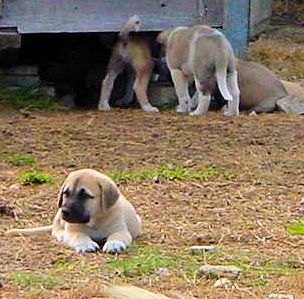
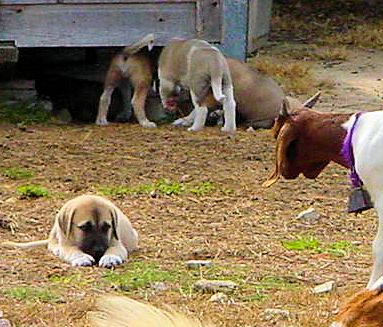
LUCKY HIT'S Shadow KASIF (CASE)
on June 23, 2001 (Case was born May 8, 2001) showing correct Anatolian submissive and respectful posturing toward an approaching goat.
In order to accurately evaluate superior working ability in Anatolian pups, it is VITAL to place the pup with excellent training goats.
I place my pups with goats when they are three weeks old. I continue to be amazed watching puppies whose eyes have
only been open a short time as they demonstrate correct submissive posture to a goat's head tilt! No training for this response is
necessary. A submissive response to the goat head tilt is a genetically instilled brain function. Those Anatolian
puppies who have the highest level of working ability begin demonstrating their superior working ability as early as three weeks,
shortly after their eyes have opened.
Serious Anatolian breeders know that working ability is the essence of the breed and will do the hard work to
ensure their breeding selections include only those Anatolians with the highest level of working ability. Working ability can only be revealed
by observing Anatolians in a true working setting... 24/7 with sheep and/or goats in a predator rich environment.
Anyone can pretend that they are an Anatolian breeder. But in my opinion, those individuals who breed Anatolians that have not been tested for
superior working ability are NOT Anatolian breeders. They might be show people who are more interested in show wins, titles, and honors than
they are in preserving the breed as developed in Turkey over thousands of years. They might be puppy mill people who are more interested
seeing what kind of profits they can make through breeding. They might claim how dedicated they are to the breed and talk about all the
health testing they do.
But only those breeders who test their Anatolians 24/7 with sheep and/or goats in a predator rich environment
and select only the superior working Anatolians for breeding can claim to be true Anatolian breeders because they are testing for the
essence of the breed. They are testing for the traits that formed this breed over thousands of years into a superior livestock guardian!
They are true breed preservationists!
To properly reveal these excellent working responses in young Anatolian pups, the breeder must create the correct training environment.
The Anatolian pup's environment must contain only superior training goats. Superior training goats CANNOT BE WEAK and they CANNOT BE MEAN.
Even if the pup is less than incredible, a correct training environment will develop that pup to its highest level of working ability!
Weak goats are unable to immediately and decisively stop all attempts at puppy play!
Weak goats are afraid of the playful puppy and want to run away from the play rather than correct it.
When you see this goat behavior, remove that goat IMMEDIATELY! Correct training goats must be
secure and strong enough when placed with an Anatolian pup that the training goat assertively
stands up to the Anatolian pup and corrects that pup for all inappropriate puppy behavior.
Mean goats, on the other hand, don't respond to a pup's submissive behavior. Mean goats continue punishing
the pup even when the pup has dropped to the ground to show respectful submission to the goat.
Mean goats are overly aggressive - mean goats don't limit their aggressive behaviors to stopping inappropriate puppy play.
Mean goats continue to butt and harrass the pup even after the pup demonstrates it regrets its playful behavior
by dropping to the ground in submission to the goat. Mean goats appear to enjoy bullying the correctly submissive pup!
When you see this type of goat behavior, remove that goat IMMEDIATELY! Remember, Anatolians have two sides,
sweet and aggressive. If a pup remains with a mean goat long enough, the pup will eventually be triggered to switch to
its aggressive side. You don't want your pup to believe it needs to be dominantly aggressive to all its charges!
EITHER TYPE OF GOAT MUST BE IMMEDIATELY REMOVED FROM THE PUPPY AREA!
NOT REMOVED LATER AND NOT REMOVED TOMORROW.... IMMEDIATELY REMOVED!
One of my all time favorite training goats was an older Boer/Kiko female with VERY LONG HORNS! She
liked Anatolians and treated the pups somewhat like she treated kids. When they were behaving
correctly, following goat herd etiquette, she completely ignored them. However, the moment
any inappropriate behavior appeared (for instance, jumping up on her back as she grazed) she
would flip her head around and bob the pup with one of her long horns! She seemed to know
the exact amount of force to use to permanently stop the pup's inappropriate action and receive an
appropriately respectful response from the pup. One appropriate strike of her horns and then she
went back to grazing. And the puppy learned its lesson!

LUCKY HIT'S Shadow KASIF (CASE)
with my older Boer/lKiko female with Very Long Horns!
Another amazing thing about excellent working Anatolian pups is that they seem to recognize
appropriate goat corrections and accept them!!! They also seem to recognize just plain old
bullying. At some point, they DON'T accept bullying and put a stop to it!
Helplessly watching my
first Anatolian,
Ebling's KASIF (CASY), being bullied by rams, I didn't understand it was my duty to remove
these bullies from my pup's pasture. Back in 1985, no one I called actually knew
what I should do. Working Anatolians were too new to the farm/ranch setting.
When Casy was 11 months old, he walked out of the barn slowly and respectfully through
a variety of sheep and goats, his head lowered correctly. From the side seemingly
out of nowhere, once again a ram leaped forward, slamming into his body, rolling him over!
This had been happening for months. Casy had been getting up and showing submission.
However, this time he was done with it! Casy had firmly identified that this behavior
was bullying and he would not be bullied again! He leaped forward, grabbing the ram
by the neck. Casy snarled and growled with viscious ferocity while shaking his head and the ram's
neck violently. I imagined the ram's neck was being torn to ribbons! It only lasted
about three seconds but it was terrifying! Then Casy dropped off the ram and the
ram ran off.
Certain the ram would need medication, I caught the offending ram. To my amazement,
there were no holes and no blood! Over the next few days I watched as Casy moved
from ram to ram with the same kind of warning attack until he had taught every ram
in the herd that he was OFF LIMITS! After that, the rams moved away as Casy walked
through the herd, completely submissive to him, clearly respectfully afraid of him!
They had received Casy's message. NO BULLYING!!!!
I learned a message that day also! NEVER BULLY AN ANATOLIAN! NEVER! Luckily,
bullying is not in my nature. But those who work with Anatolians need to heed
Casy's message! You can get away with bullying an Anatolian for only so long!
Then, at some point the Anatolian will identify YOU as a bully and put a stop
to it! After that, the Anatolian requires that YOU respect HIM. He no longer
has respect for you!!!!
Even though this corrective behavior toward bullying is generally not demonstrated until
Anatolian pups are a bit older, it is necessary that superior working Anatolians
possess this behavior. Without it, they forever remain submissive to the bullies
in their herd!!! It is also indicative of an Anatolian who is willing to protectively
defend his charges against large and serious predators!!! WARNING!!! It also means
that NO ONE who has a tendency to bully should ever own an Anatolian!!
|
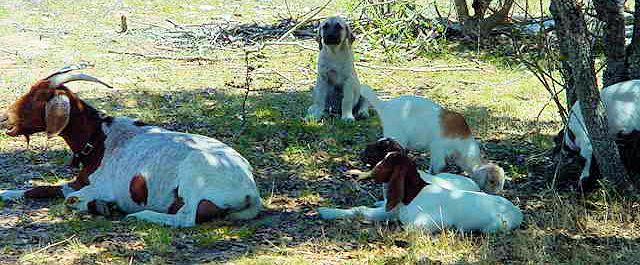
LUCKY HIT'S Shadow KASIF (CASE)
watching kids without needing to play and/or chase.
The superior Anatolian pup is happy to watch their charges play with each other
without needing to play with and/or chase their charges.
It is not desirable when a pup has the urge to play and chase their sheep and/or goats,
especially if there is a predatory aspect to the puppy play. Rather than play with their
charges, the pup should turn to another pup or an older Anatolian for play. When my pups do this,
they tend to move to an area away from the goats, knowing that their play might create
a disturbance in the herd!
If a pup has no other Anatolians to play with, the best Anatolians will still
refrain from play with their charges and find other ways to use up their excess
energy. This doesn't mean that an Anatolian that has to be taught to refrain
from play isn't good. Some of these Anatolians are incredibly bonded to their charges,
making the pup have more difficulty distinguishing between a goat and another pup!
However, when chosing the best working pup, the Anatolian pup that requires no
correction for improper play is demonstrating the highest level of working behavior!
Avoid the pup that strongly desires to engage in play/chase/grab behaviors
(chase and grab are predatory), especially when the pup isn't inclined to stop
immediately and doesn't show remorse when chastized by either you or the goat,
indicating a stronger predatory nature. This unrepentant pup is less desirable
as a breeding prospect since predatory behaviors are completely unacceptable in
Anatolians. All predatory behaviors are to be avoided when selecting the superior
working Anatolian pup!
The presence or absence of these behaviors can only be seen in pups raised in a true
working situation. Without properly raising pups with sheep and/or goats, the pup's
level of desire to play and chase their charges cannot be determined! Breeders
dedicated to Anatolian breed preservation know that the essence of the breed,
superior working ability, can only be determined by raising Anatolians with sheep
and/or goats! Health testing is a good thing. However, when breeding Anatolians
health testing is not a substitute for a so-called "breeder's" failure to properly test for
superior Anatolian working ability, the defining characteristic of the breed!
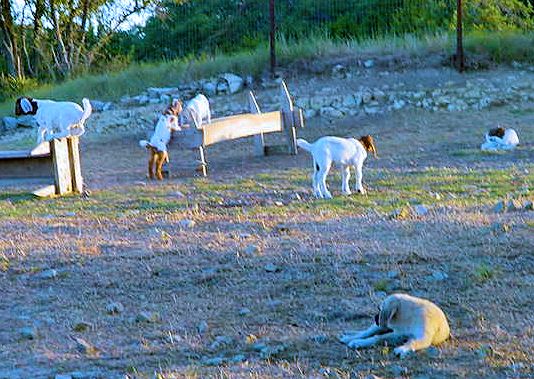
LUCKY HIT'S Shadow KASIF (CASE)
watching kids without needing to play and/or chase!
|
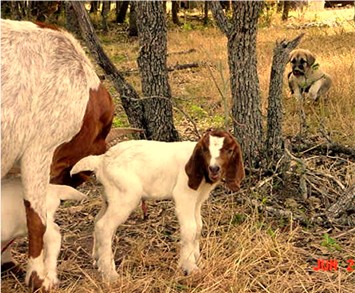
LUCKY HIT'S Shadow MAJOR (MAJOR)
fascinated as he watches a goat have kids for the first time. Major automatically
knows to respect the birthing goat. He maintains space between himself and the goat/kids.
Superior working Anatolians have a respectful fascination with newborn kids. They watch and protect without interferring with the bonding between the goat and her newborns!
I have noticed that the manner an Anatolian interacts with kids is similar to the manner in which that dog interacts with puppies!
The superior Anatolian pup will be drawn to a birthing mom and her newborn kids. But they will remain respectful
to the mom and kids. If the mom is nervous and tilts her head to the pup, the superior working pup
will step back or lay down on its side in submission. Some exceptional pups will be so
drawn to newborns that they will slowly crawl to the newborn on their side (so the mom
isn't alarmed) just to lightly and lovingly lick the newborn.
At no time will the superior pup grab or play with the newborn. They will also not want
to leave the newborn and can spend hours lying down watching the newborns with adoration.
The greater dedication and love toward a newborn a pup displays the greater dedication
and love that pup will give to his/her flock as he/she matures!
Exceptional working ability is a genetically instilled trait. If you want your pup to have
superior working ability, the more generations of proven superior working Anatolians your
pup has in it's ancestry, the greater the likelihood that you pup will also have
superior working ability. When an Anatolian "breeder" hasn't diligently selected for
superior working ability at every generation, don't be surprised when that breeder's pups
turn out to have erratic working ability! Remember, show wins, no matter how impressive,
are not indicators of exceptional working ability!!! In fact, generic show dog behaviors
are antagonistic to excellent working behaviors!!
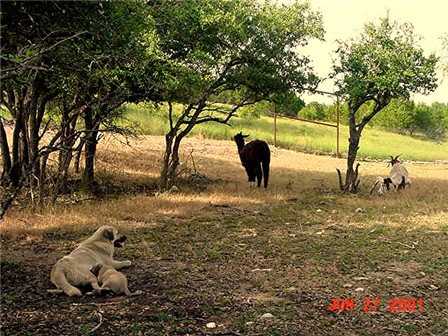
CONARD'S Tawny SHADOW (SHADOW)
nursing a pup while watching over a goat have her kids.
|
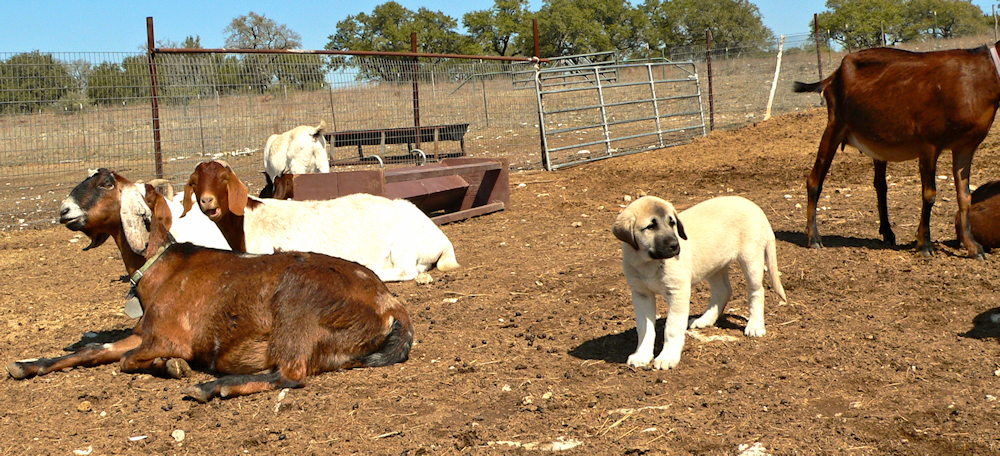
CHAMPION Ashley Manor DivaKiz of LUCKY HIT (KIZZIE)
on February 26, 2006, when about to turn two months. Kizzie had just arrived at Lucky Hit Ranch,
and was calmly walking around the corral to check out her new friends.
Kizzie is an example for an Anatolian with excellent working genetics. She was raised
for her first eight weeks with her dam,
CHAMPION LUCKY HIT'S Shadow DIVA (DIVA) , and Kizzie's 13 siblings, without sheep and/or goats.
Yet when she was introduced to all the animals here at Lucky Hit Ranch, she behaved
perfectly with them, showing her calm and watchful nature, a demeanor resulting in behaviors that engender
a feeling of safety in sheep and/or goats.
While Kizzie was a truly superior working Anatolian, if she'd been raised here at Lucky Hit she would
have been placed in the pasture with her dam, her sire or another breeding male prospect, and some
aunts and/or cousins as well as goats and llamas at three weeks of age. Even without those early
experiences, her genetic working ability with animals allowed her to excel as a working guardian!
Superior working Anatolians reveal a calm and watchful nature. They are not excitable
and think about what they are watching. They love being a part of the goat group.
If all is well, they are happy to sit and lie down and watch their animals.
In an article published in 1980 by Ray Coppinger, he wrote, "At a distance, the dogs were inconspicuous,
blending in with the sheep because of their behavior as well as their color. …"
Sheep and goats are placid and deliberate when grazing and they do not socialize with each other
in the engaging way selected for in many pet dogs. Aloof guardians mimic the less social behavior
of their charges (desirable Anatolian behavior) while more social guardians stand out from the herd
(undesirable Anatolian behavior).
The truly superior pup has an array of creative behaviors to allow their charges to feel
at ease! As they approach, if a goat seems nervous or apprehensive the superior pup
might reach down for some grass or a stick and chew it slowly, looking away from the goat.
The pup might lie down, moving slowly, perhaps only glancing at the goat.
This pup knows the signals to reassure the goats that it is "just another grass eater and
no problem at all!"
Superior working Anatolians might move away when a goat is challenging, but not too far
and not too fast. An even higher level of working ability is seen when, rather than move
away, the pup stands still with a calm submissive demeanor without any challenge to
the goat. If the goat attempts to actually butt the pup, the most
excellent pup will move back a bit to avoid the butt and then stand passively,
demonstrating with their posture and demeanor that they are no threat whatsoever to the goat. With
the correct demeanor and appropriate movements, this most superior pup can calm
even somewhat aggressive and aggitated goats. This calm confidence with goats can
only be seen in Anatolian pups with the highest level of working ability!
This level of superior working ability can best be achieved through careful selection
of every breeding pair for superior working ability for generations. When working
ability is not a breeder's top priority, the general level of working ability
in that Anatolian line will be reduced over time! Your cannot maintain superior
Anatolian working ability, the essence of this breed, without actually testing for
it and selecting for it as your highest breeding priority! If a "breeder's" situation
doesn't allow for them to maintain sheep and/or goats in a predator rich environment,
there is something they can do to help infuse their line with working genetics.
They can pick a proven, superior working Anatolian to breed with their unproven
(show-only?) Anatolian. At least one of the parents will have proven working
genetics to contribute to the pups! That's better than picking another (show-only?)
unproven Anatolian.
When a "breeder"
has been selecting other traits (for instance, traits they believe will help them
win top show awards) but that "breeder" has no way to actually evaluate which
of their pups have the highest level of working ability (that requires the pup live
with sheep and/or goats in a predator rich environment), I question that breeder's
dedication to the breed. Winning at shows is NOT the essence of the breed!
Superior working ability is! Responsible breeders recognize that fact and therefore
make working ability their primary breeding criteria!!!
Selecting for superior conformation is easy! I can watch an Anatolian trot and
am able to see and evaluate that dog's conformation. I don't require a judge to
tell me whether or not my dog has excellent conformation! Sadly, even after all this
time some judges don't understand correct Anatolian conformation and demeanor! I have
experienced this lack of understanding first hand so I trust my own evaluation of
my dogs' conformation!
Although a knowledgable working breeder can spot signs of excellent working ability,
behavior, and demeanor in Anatolian pups, it takes years to fully evaluate the entirity
of an Anatolian's true working abilities and this evaluation can only be done
with sheep and/or goats in a predator rich enviornment!
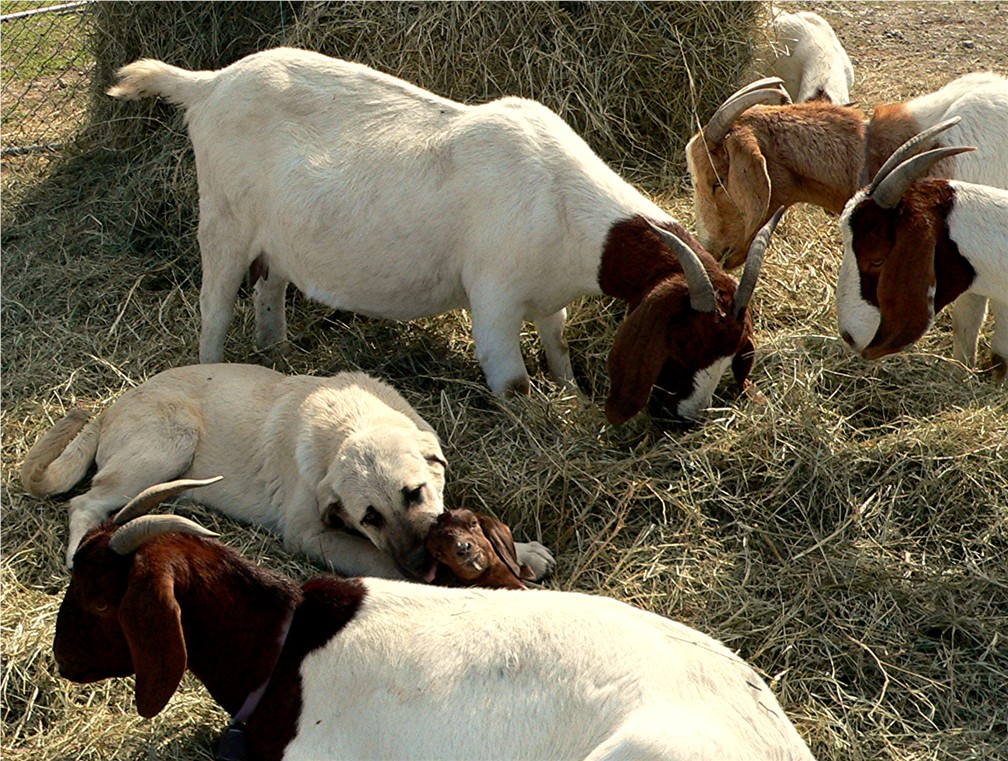
LUCKY HIT Sahara BENEK (BENEK)
Pictured here at four months within the herd, Benek is sweetly and gently
licking a young kid. Benek is allowed in the herd with young kids because she
is calm and has a respectful demeanor toward all the goats, including the young kids!
Her desire to be with goats, especially young kids, was obvious from an early age!
Only Anatolians that show they have this ability to move among goats and/or sheep
without creating anxiety in their charges, especially when young kids are involved,
should be bred. Of course, only those Anatolian pups raised in a true working
setting (with sheep and/or goats in a predator rich environment) are in an
environment that will reveal whether or not the pups have this ability! If you
are looking for an Anatolian with superior working ability, pick a pup that has
been raised with sheep and/or goats from a breeder dedicated to breed preservation.
If the breeder is satisfied to raise their Anatolians without sheep and/or goats,
how have they been able to select for working ability, much less superior working
ability? In my opinion, no matter what story a "breeder" tells you, it is
impossible to understand the level of actual working ability in Anatolians without
maintaining Anatolians with sheep and/or goats in a predator rich environment!
Also, placing an Anatolian in a pasture with some sheep/goats for promotional
pictures doesn't provide any information useful for selecting superior working
ability!
|
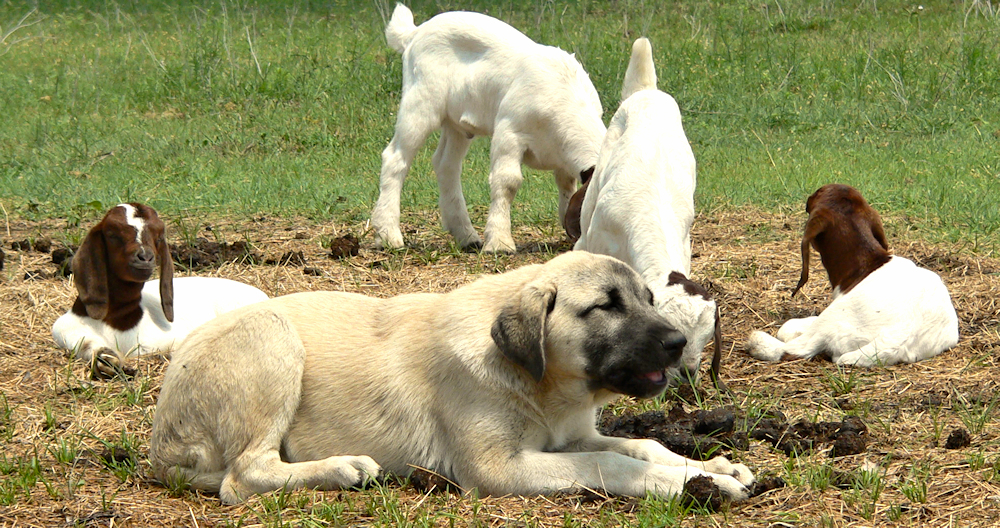
CHAMPION Ashley Manor DivaKiz of LUCKY HIT (KIZZIE)
when three and a half months old enjoying playing with a predator's skin as she
lounges near her goat friends.
Kizzie's dam, CHAMPION LUCKY HIT'S Shadow DIVA (DIVA) ,
was raised working with goats and when about 4 months old began guarding alpaca.
Superior working Anatolians love spending time near their charges. This love of their
animals can be seen when a goat's head is stuck in the fence and the young pup will
not leave the goat, even for supper. Another example is when a young and inexperienced
goat leaves her newborn kid in the pasture to stay with the herd. The superior Anatolian
pup will sit patiently by the kid, knowing that the newborn is vulnerable and in need of
protection if it is to survive.
Another behavior I like to see in young working pups is pups who seek the protection
of the herd when they perceive some sort of potential danger. When pups run to the
goat herd and hide among the herd, I am thrilled! In my experience, young pups that
rely on the herd for protection and safety will evolve into a mature guardian dog
with a strong instinct to protect the herd. Seeking protection in the herd indicates
a strong bonding with herd animals (sheep and/or goats), which is necessary in all
superior working Anatolians! Only breeders who maintain their Anatolians with sheep
and/or goats have the ability to look for and identify this essential bonding trait!
"Breeders" who fail to maintain their Anatolians with sheep and/or goats are not
testing for the Anatolian trait that formed the breed through thousands of years
of selection - superior ability to guard sheep and/or goats in a predator rich
environment. Since superior working ability is the core essence of the true Anatolian,
how responsible are "breeders" who fail to test their breeding Anatolians
for the essence of the breed?
Regarding this desirable Anatolian trait of spending time near their charges, in 1980 Ray Coppinger
wrote, "It's this apparent preference for the company of sheep over anything else that shapes
the whole behavioral repertoire of a livestock guarding dog. Not only do the dogs act as
if they themselves were members of the flock, but they stay right with it wherever it goes."
Sadly, it appears that heavy selection for generic show traits have decreased this
important trait in Anatolians. When selecting the superior pup, look for that pup
that demonstrates the greatest love of their sheep and/or goats by wanting to stay with
the flock almost all the time! Of course, "breeders" who don't have sheep and/or goats
really don't know if their pups do or do not possess this vital working trait!
I identified superior working ability in some of my very best Anatolians as early as
five weeks. Rather than joining the puppy pile for a nap I would find these truly
superior working pups snuggling up against a resting goat! Or while the rest of the
young pups were playing with each other, the most superior working Anatolian pups were
walking with goats as the goats grazed. These most superior working Anatolians
showed a clear preference for the company of my goats over the company of their
littermates!
In his 1980 article, Ray Coppinger also wrote, "Guarding dogs are placid, deliberate,
and aloof; they work alone and without constant supervision. They respond slowly
if at all to commands..." Desirable pups are aloof guardians who mimic the
less social behavior of their charges. More social guardian pups stand out from
the herd, which is not desirable. Look for those less social, more aloof pups when
selecting traits for superior working ability!
Those less social traits can be seen in Anatolian puppies. Look
for the Anatolian pup that sits back and watches as strangers enter their pasture.
The pup who runs up with friendliness and energy may not be the best working
Anatolian since they should be suspicious of strangers. Listen to the breeder as
he/she describes the pup's behavior and then watch for yourself how the pup behaves.
Is the pup responsive to the sheep/goat commands
(head tilt, leg pop, etc) with submission and compliance? It should be. Many of the
traits we look for in a pet dog are not appropriate or desirable in an Anatolian.
Any trait that reduces the Anatolian's effectiveness as a guardian should be selected
against when looking for the superior Anatolian pup! Many traits beneficial to the generic
show dog or the beloved house pet are antagonistic to excellent working ability!!!
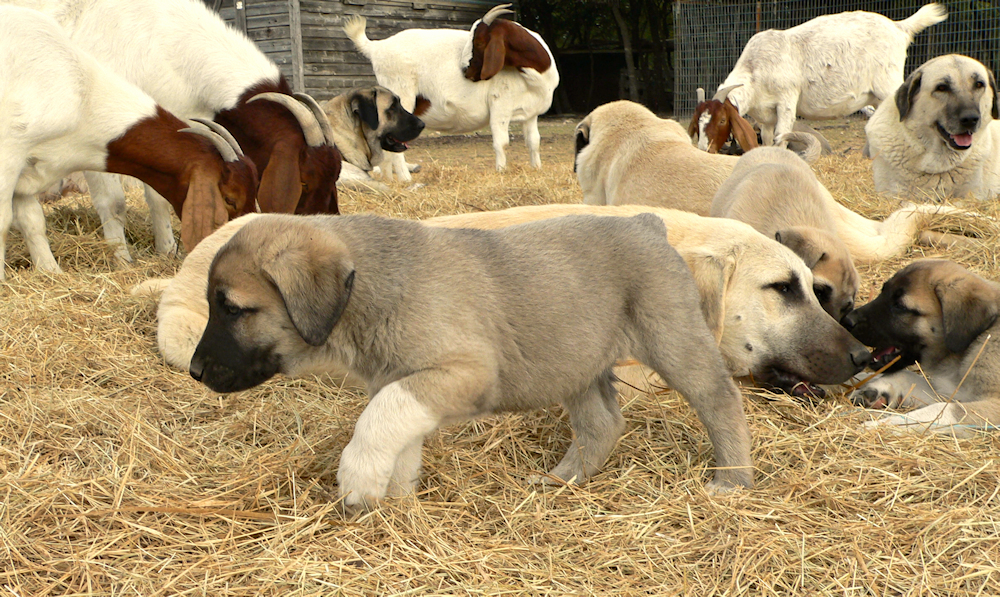
CHAMPION LUCKY HIT'S Sahara LUKA (LUKA)
Pictured here at eight weeks living with his siblings, dam, aunts and cousins as
well as goats and llamas. Growing up with his goats since he was three weeks old
allows him to develop a loving relationship with his charges!
My advice is to avoid "breeders" who are not able to evaluate their Anatolians'
working ability because they don't have goats and/or sheep! After all, WORKING
ABILITY IS THE ESSENCE OF THE BREED! Dedicated breeders will ensure that they
have an appropriate environment to test for the breed essence! Otherwise they
have no real way to evaluate whether or not their Anatolians have superior
working ability or terrible working ability!!!
|
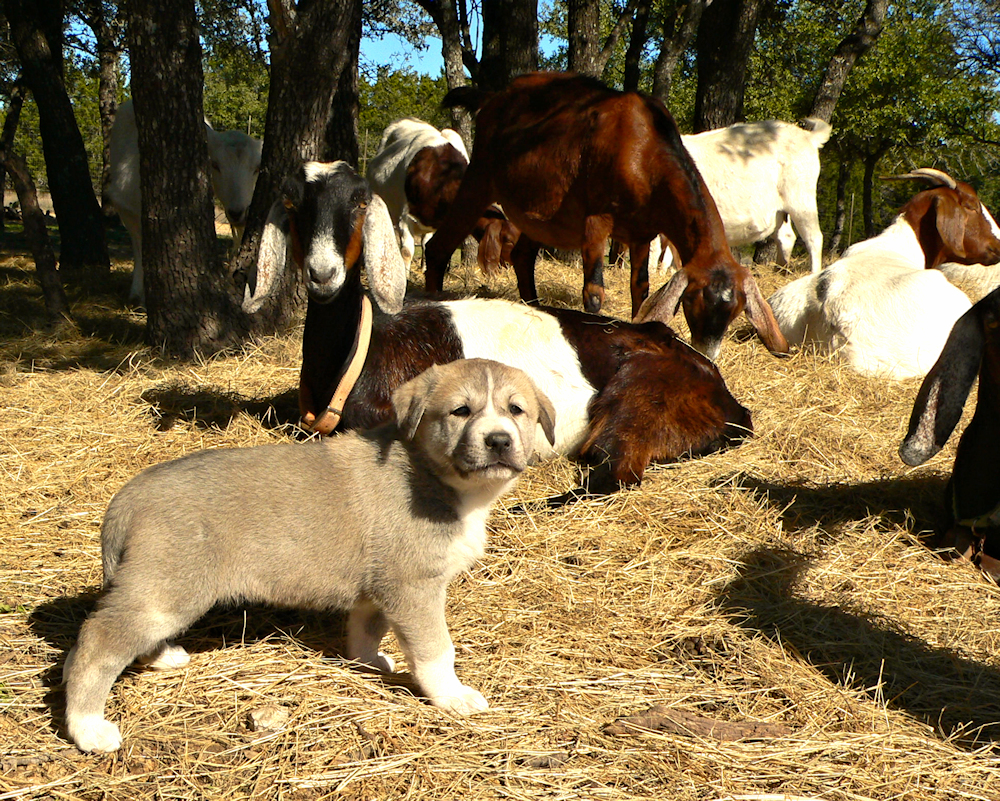
CHAMPION LUCKY HIT Bethany KAMIL (KAMIL)
Pictured here at five weeks and three days with her goats. Kamil was placed outside
in a shed with these goats two weeks earlier. Anatolians selected for superior
working ability are able to perfectly exist with their training goats from a
very early age. Even at three weeks, excellent working genetics allows an
Anatolian pup to move among their training herd with ease!!!
A major factor in selecting a pup with a superior level of working ability is
to select that pup whose ancestors have proven that they have a high level of
proven working ability. This fact has been know for generations. In
an article originally appearing in the April, 1980, issue of "Amateur Farmer"
[reprinted in the Anatolian Times (Vol. 1, 2008, pgs. 25-29)],
Livestock-Guardian Dogs, An Old World Solution to an Age-Old Problem ,
by Ray Coppinger and Lorna Coppinger, they state, "We're finding that there's
no great mystery about raising and training guarding dogs. Getting a good one,
however, is tricky. … but the buyer should be extremely careful in choosing a
kennel and making certain that the pup comes from working stock. Your chances
of success are greater if your dog's immediate ancestors guarded livestock. …
However, not every dog is a good dog, outstanding parents or not,
and this is true of all working breeds."
IN EUROPE (including TURKEY) ALL DAY SHEPHERDS ARE COMMON. That means that a pup has
someone available to supervise his training all day. Pups are not left unsupervised!
Yet here in the U.S. many livestock guardian owners just throw the pup out with
their goats, sheep, chickens, ducks, horses, llamas, etc. and believe the pup
will train itself.
Sadly, many "breeders" have told prospective new owners this ridiculously seductive
lie - that Anatolians don't need supervision!!! All young Anatolians require guidance
to be shaped in the fashion desired by the owner (but only within the bounds of what
an Anatolian is - you can't make a well-bred guardian Anatolian into an unprotective
lap-dog!
To make matters even worse, some Anatolian "breeders" tell first time owners
to put the pup with young stock "and they'll grow up together!" Horrible advice!!!
Somewhat like advising a two-year-old to baby-sit another two-year-old!
The key to selecting a excellent working pup is to obtain the pup whose genetics
allow the pup to easily learn correct behaviors and demeanor from carefully selected
training sheep/goats. However, it is still up to the owner to evaluate the sheep/goat
interactions with the pup. If the pup's level of dominance has outgrown
the sheep/goats level of dominance, the owner must immediately change out those
training animals for animals who demand and receive correct responses. Caution!
No mean or bullying training animals!!!
Be wary of those Anatolian "breeders" who say that all Anatolians have excellent
working ability! They don't! There is a great deal of variation in the level of
working ability in Anatolians, even in pups from the same litter. This is why it
is vital to select your working pups from lines with many generations of proven
working ability.
In Turkey, they had to work well or they were killed. Here in the United States,
you can find lines that have many generations of unproven Anatolians.
The more unproven genetics in a pup's ancestry the greater the chance that their
working ability may not be the best!!! Their parents might have been health
tested and/or evaluated by judges (many who have never owned an Anatolian), but those
evaluations contribute almost NOTHING toward whether the pups will tend to be EXCELLENT
or POOR working Anatolian! In order to save yourself a bunch of work, look for
Anatolian breeders who have focused for many Anatolian generations on superior
Anatolian working ability! Of course, those breeders will raise all of their
Anatolian with sheep and/or goats in a predator rich environment!!!!
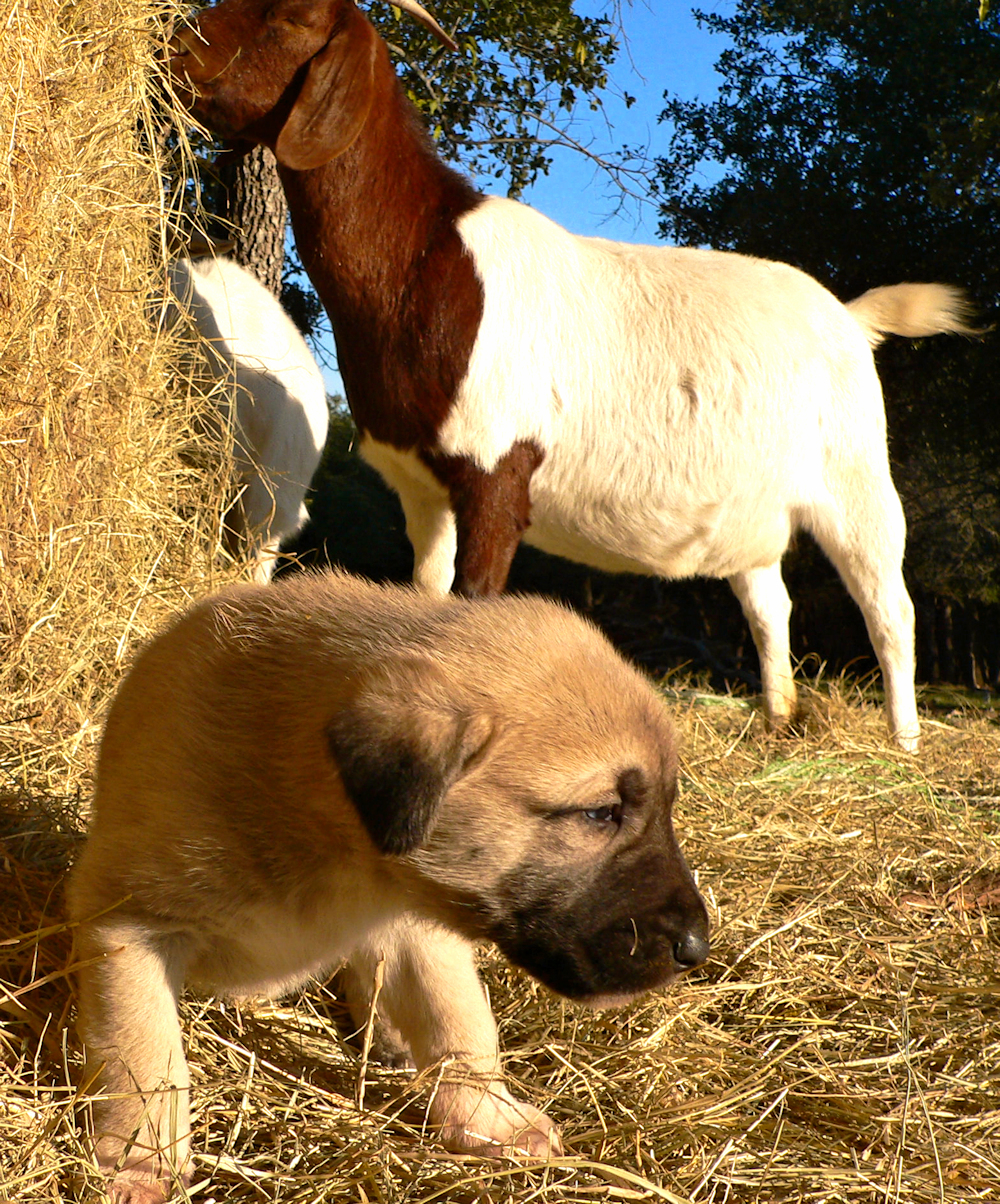
BRONZE CHAMPION LUCKY HIT Bethany YAMIN (YAMIN)
#1 AKC ANATOLIAN IN 2015
Pictured here at four weeks calmly walking around with his training goats!
If a breeder is afraid to place their young Anatolian pups with selected training
sheep and/or goats, perhaps it's because they believe that their Anatolians do not
have the correct working responses to ensure the safety of their pups!!!!
The LUCKY HIT theory is that pups are either Anatolians or they are not! Anatolians
have the proper working genetics to safely co-exist with selected training sheep and/or goats.
If a "breeder's" pups can't safely co-exist with training sheep and/or goats because
they lack the proper genetically-instilled herd communication behaviors and demeanor, I wouldn't
consider those pups Anatolians no matter what their registration papers say!!!
That being said, we must remember that it is the owner who selects the training
animals. Perhaps the owner hasn't diligently selected the proper goats to train
the Anatolian pup!!! Before one automatically blames all the pup's problems on
the pup, let's first look at what the owner has and has not done to ensure the
pup's environment is correctly structured to properly train that pup!!! Many times
an Anatolian pup's guardian problems stem from the owner's inability to correctly
structure the pup's environment!!!
When one purchases an Anatolian pup one has made a committment to that pup. Whether
the pup is totally perfect and does everything right or the pup seems to magically
discover every incorrect behavior possible in a livestock guardian,
it is the owner's responsibility to work with the pup through each and
every problem in order to develop that pup into the best working guardian achievable.
It is vital that prospective owners diligently research the background of
every pup and breeder they can. It is far better to do the research and end up
with an excellent working Anatolian than to skip the research and end up with
a pup with low potential to become a superior working Anatolian!!!
|
After some individuals read this article, I was asked the following questions:
1. Why are we breeding dogs that would be considered culls in Turkey? When
Anatolians haven't been tested for working ability and have traits indicating
they are poor working prospects, why do so many breeders breed them anyway?
2. How many American Champion Anatolians would have been killed in Turkey for
failing to do the job they were bred to do?
3. In this country we rarely cull our animals aggressively, even those animals
raised for slaughter. Without vigorously culling our Anatolians aren't we
just downgrading the superior working ability of the Anatolians with
which we've been entrusted?
3. Many Anatolian "breeders" chastise others for failing to health test
their Anatolians. Shouldn't we also "look down on" those so called "breeders"
who fail to test for the essence of the breed... superior working ability!
4. I doubt that Turkey is willing to send their best Anatolians out of the
country. Don't we owe it to our future farmers and ranchers to preserve the best
working qualities of the breed through careful breeding selection for superior
working ability?
5. Anatolian Production vs Preservation
A production breeder doesn't care about quality... they are producing Anatolian
puppies in volume to sell for a profit. A preservation breeder, however, is breeding
to preserve the best working abilities, traits, demeanors, and behaviors of an
already superior working breed. Preservation breeders are dismayed when they
see production breeders who fail to raise their Anatolians in the correct environment
with excellent training animals surrounded by actual predators. Raised improperly
for the breed, it is impossible to accurately determine which dogs have the best
working ability! Unfortunately, it seems that many production breeders are
more interested in owning Anatolians capable of producing many litters rather than
Anatolians with superior working ability!
6. Show quality does not indicate breeding quality. We can love our dogs just
as much when they are spayed or neutered. Bottom line, a Champion without proven working
ability should be neutered, not bred. A non-show dog with superior proven working
ability is a great breeding prospect for the breed because that dog has proven it possesses
the essence of the breed, superior working ability!
7. Laziness on the part of the breeder should not be rewarded! Don't you think
that people should stop buying puppies whose parents have not proven they have
superior working ability? Shouldn't superior working ability be the primary
selection criteria for all responsible Anatolian breeders?
8. Isn't breeder support vital, especially if you haven't previously owned an
Anatolian? What should a good Anatolian breeder be doing for their puppy buyers?
Should a good breeder become defensive when the puppy buyer asks questions?
(Of course not. Responsible puppy buyers will always want to be able to freely
ask the breeder all sorts of questions as things come up.) If the breeder doesn't
know how to answer a puppy buyer's questions, doesn't this mean that the breeder
hasn't done the difficult work a serious Anatolian breeder should have done prior
to breeding?
9.
|
|
Click picture below for
Erick Conard's Address and Phone Number Information
in a New Window
Erick's Address and
 Phone Numbers Link
Phone Numbers Link
There is only one way for a breeder to actually understand the working ability of their
potential breeding Anatolians... by watching their dogs throughout their lives living
with sheep and/ or goats in a predator rich environment! Anatolians who have
not been tested for working ability in a real world guardian situation might be tested
for every potential genetic problem in the breed and may even have top Conformation awards.
However, without being tested for actual working ability the level and types of working
ability of the Anatolian cannot be known! Therefore, if that untested Anatolian is bred, the breeder is
just throwing the dice and HOPING for a good outcome. In some cases, the "breeder"
doesn't even care whether or not the Anatolian has working ability just as long as the Anatolian
has a temperament that makes it easy to show. (Excellent working temperament tends
to increase the difficulty in successfully showing Anatolians!)
Working ability is the defining essence of this breed. Only breeders willing
to do the very difficult and time consuming work of raising their Anatolians
in a true working environment can be designated as Anatolian Breed
Preservationists!
|
I hope you found my ideas about WORKING Anatolian Shepherd
Guardian Dogs interesting and useful. I strive to provide insight into the
temperament and character of good working Anatolian Shepherd Guardians by sharing
my thoughts regarding how to select the very best Anatolians. I believe in
BREED PRESERVATION, which requires using superior working ability as the primary
selection criteria!
If you are having working problems with your Anatolian,
please feel free to contact me for assistance.
|
ADDITIONAL THOUGHTS:
The most important factor when purchasing and raising an Anatolian to guard
livestock is to select your pup from two proven and superior working Anatolians.
Good or bad working behaviors are inherited, just like good or
bad hips, good or bad teeth, etc. Your pup has the greatest likelihood of
having superior working ability if he/she comes from two superior and proven
working parents. Before purchasing a pup you should visit the ranch and
carefully observe the parents to verify that both sire and dam live and work
24/7 with sheep and/or goats in a predator rich environment. Check out the
parent's behaviors for excellent and desirable interactions with their sheep
and/or goats. If you don't like the parent's behaviors you might not
like the puppy's behaviors!
Breeders who tell you "all Anatolians have good working ability" are
probably just trying to sell their pups, since there is a wide variation
in working ability depending on the working genetics of the parents!
My experience is that when a breeder has failed to focus on superior
working ability as their top breeding requirement, it is possible
that the pups they are producing may not have the high level of working
ability that you require!
|
|
 Phone Numbers Link
Phone Numbers Link
 Phone Numbers Link
Phone Numbers Link













 Click Picture to Return to Anatolian Main page
Click Picture to Return to Anatolian Main page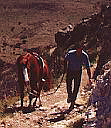 Click Picture to Return to Lucky Hit Main Home Page
Click Picture to Return to Lucky Hit Main Home Page